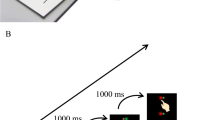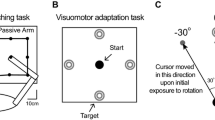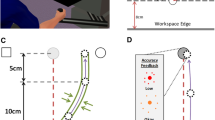Abstract
Aging is associated with impaired upper limb proprioceptive acuity, as reflected by decreased position matching accuracy with increasing task complexity and movement extent. Most studies have primarily used single-joint or planar paradigms to examine age-related changes in proprioception. It is unclear whether these changes can be generalized to more complex multi-joint movements, where additional sensory feedback may affect performance. Since age-related declines in cognitive function may impair the ability to integrate multiple sources of sensory feedback, deficits in position matching ability in older adults may persist when tasks are performed in three-dimensional space. The accuracy with which young and older participants reproduced remembered reference hand positions was assessed under different experimental conditions. Participants matched target locations located directly to the front or 45° to the side relative to the midline using the preferred and non-preferred arms. Either the same (i.e., ipsilateral matching) or the opposite (i.e., contralateral matching) arm was used to reproduce the target location. No differences in matching accuracy were found between young and older participants when matching ipsilaterally. When matching contralaterally, accuracy was worse in older participants for target locations located to the side, which may reflect age-related changes in the perception of peripersonal space. In contrast to previous studies, accuracy did not differ between the preferred and non-preferred arms in either group. These results extend previous findings demonstrating age-related impairments in proprioceptively guided arm movements when interhemispheric transfer is required.





Similar content being viewed by others
References
Abe O, Aoki S, Hayashi N, Yamada H, Kunimatsu A, Mori H, Yoshikawa T, Okubo T, Ohtomo K (2002) Normal aging in the central nervous system: quantitative MR diffusion-tensor analysis. Neurobiol Aging 23(3):433–441
Adamo DE, Martin BJ, Brown SH (2007) Age-related differences in upper limb proprioceptive acuity. Percept Mot Skills 104:1297–1309
Adamo DE, Alexander NB, Brown SH (2009) The influence of age and physical activity on upper limb proprioceptive ability. J Aging Phys Act 17:272–293
Adamovich SV, Berkinblit MB, Fookson O, Poizner H (1999) Pointing in 3D space to remembered targets I: kinesthetic versus visual target presentation. J Neurophysiol 79:2833–2846
Bloesch EK, Davoli CC, Abrams RA (2013) Age-related changes in attentional reference frames for peripersonal space. Psychol Sci 24(4):557–561
Bosco G, Poppele RE, Eian J (2000) Reference frames for spinal proprioception: limb endpoint based or joint-level based? J Neurophysiol 83(5):2931–2945
Brauer SG, Woollacott M, Shumway-Cook A (2001) The interacting effects of cognitive demand and recovery of postural stability in balance-impaired elderly persons. J Gerontol A Biol Sci Med Sci 56(8):M489–M496
Brooks JL, Della Sala S, Darling S (2014) Representational pseudoneglect: a review. Neuropsychol Rev 24(2):148–165
Carson RG, Elliott D, Goodman D, Dickinson J (1990) Manual asymmetries in the reproduction of a 3-dimensional spatial location. Neuropsychologia 28(1):99–103
Chapman CD, Heath MD, Westwood DA, Roy EA (2001) Memory for kinesthetically defined target location: evidence for manual asymmetries. Brain Cogn 46(1–2):62–66
Cordo PJ (1990) Kinesthetic control of a multijoint movement sequence. J Neurophysiol 63(1):161–172
Darling WG, Viaene AN, Peterson CR, Schmiedeler JP (2008) Perception of hand motion direction uses a gravitational reference. Exp Brain Res 186(2):237–248
Fling BW, Peltier SJ, Bo J, Welsh RC, Seidler RD (2011) Age differences in interhemispheric interactions: callosal structure, physiological function, and behavior. Front Neurosci 5:38
Folstein MF, Folstein SE, McHugh PR (1975) “Mini-mental state”: a practical method for grading cognitive state of patients for the clinician. J Psychiatr Res 12(3):189–198
Fuentes CT, Bastian AJ (2010) Where is your arm? Variations in proprioception across space and tasks. J Neurophysiol 103(1):164–171
Gandevia SC, Smith JL, Crawford M, Proske U, Taylor JL (2006) Motor commands contribute to human position sense. J Physiol 571(Pt 3):703–710
Gentili R, Cahouet V, Papaxanthis C (2007) Motor planning of arm movements is direction-dependent in the gravity field. Neuroscience 145(1):20–32
Ghafouri M, Lestienne FG (2000) Altered representation of peripersonal space in the elderly human subject: a sensorimotor approach. Neurosci Lett 289(3):193–196
Goble DJ, Brown SH (2007) Task-dependent asymmetries in the utilization of proprioceptive feedback for goal-directed movement. Exp Brain Res 180(4):693–704
Goble DJ, Brown SH (2008) The biological and behavioral basis of upper limb asymmetries in sensorimotor performance. Neurosci Biobehav Rev 32(3):598–610
Goble DJ, Brown SH (2009) Dynamic proprioceptive target matching behavior in the upper limb: effects of speed, task difficulty and arm/hemisphere asymmetries. Behav Brain Res 200(1):7–14
Goble DJ, Lewis CA, Hurvitz EA, Brown SH (2005) Development of upper limb proprioceptive accuracy in children and adolescents. Hum Movement Sci 24(2):155-170
Goble DJ, Lewis CA, Brown SH (2006) Upper limb asymmetries in the utilization of proprioceptive feedback. Exp Brain Res 168(1–2):307–311
Goble DJ, Coxon JP, Wenderoth N, Van Impe A, Swinnen SP (2009) Proprioceptive sensibility in the elderly: degeneration, functional consequences and plastic-adaptive processes. Neurosci Biobehav Rev 33(3):271–278
Gribble PL, Ostry DJ (1999) Compensation for interaction torques during single- and multijoint limb movement. J Neurophysiol 82(5):2310–2326
Haggard P, Wolpert DM (2005) Disorders of body scheme. In: Freund H, Jeannerod M, Hallett M, Leigaruda R (eds) Higher order motor disorders. Oxford University Press, Oxford, pp 261–271
Haggard P, Newman C, Blundell J, Andrew H (2000) The perceived position of the hand in space. Percept Psychophys 62(2):363–377
Haggard P, Taylor-Clarke M, Kennett S (2003) Tactile perception, cortical representation and the bodily self. Curr Biol 13(5):R170–R173
Helms Tillery SI, Flanders M, Soechting JF (1994) Errors in kinesthetic transformations for hand apposition. NeuroReport 6(1):177–181
Helms Tillery SI, Soechting JF, Ebner TJ (1996) Somatosensory cortical activity in relation to arm posture: nonuniform spatial tuning. J Neurophysiol 76(4):2423–2438
Herter TM, Scott SH, Dukelow SP (2014) Systematic changes in position sense accompany normal aging across adulthood. J Neuroeng Rehabil 11:43. doi:10.1186/1743-0003-11-43
Horak FB (2006) Postural orientation and equilibrium: what do we need to know about neural control of balance to prevent falls? Age Ageing 35(Suppl 2):ii7–ii11
Hultsch DF, MacDonald SW, Dixon RA (2002) Variability in reaction time performance of younger and older adults. J Gerontol B Psychol Sci Soc Sci 57(2):P101–P115
Jueptner M, Willer C (1998) A review of differences between basal ganglia and cerebellar control of movements as revealed by functional imaging studies. Brain 121(8):1437–1449
Karduna AR, Sainburg RL (2012) Similarities in the neural control of the shoulder and elbow joints belie their structural differences. PLoS ONE 7(10):e45837. doi:10.1371/journal.pone.0045837
King J, Karduna A (2014) Joint position sense during a reaching task improves at targets located closer to the head but is unaffected by instruction. Exp Brain Res 232(3):865–874
King J, Harding E, Karduna A (2013) The shoulder and elbow joints and right and left sides demonstrate similar joint position sense. J Mot Behav 45(6):479–486
Kokmen E, Bossemeyer RW Jr, Williams WJ (1978) Quantitative evaluation of joint motion sensation in an aging population. J Gerontol 33(1):62–67
Kuo AD (2005) An optimal state estimation model of sensory integration in human postural balance. J Neural Eng 2(3):S235–S249
Langan J (2014) Older adults demonstrate greater accuracy in joint position matching using self-guided movements. Hum Mov Sci 36C:97–106
Li K, Lindenberger U (2002) Relations between aging sensorimotor and cognitive functions. Neurosci Biobehav Rev 26(7):777–783
Lin CH, Lien YH, Wang SF, Tsauo JY (2006) Hip and knee proprioception in elite, amateur, and novice tennis players. Am J Phys Med Rehabil 85(3):216–221
Lovelace EA, Aikens JE (1990) Vision, kinesthesis, and control of hand movement by young and old adults. Percept Mot Skills 70(3 Pt 2):1131–1137
McGuire LM, Sabes PN (2009) Sensory transformations and the use of multiple reference frames for reach planning. Nat Neuroscience 12(8):1056–1063
Oldfield RC (1971) The assessment and analysis of handedness: the Edinburgh inventory. Neuropsychologia 9:97–113
Papaxanthis C, Pozzo T, McIntyre J (2005) Kinematic and dynamic processes for the control of pointing movements in humans revealed by short-term exposure to microgravity. Neuroscience 135(2):371–383
Pijnappels M, Kingma I, Wezenberg D, Reurink G, van Dieën JH (2010) Armed against falls: the contribution of arm movements to balance recovery after tripping. Exp Brain Res 201(4):689–699
Proske U, Gandevia SC (2009) The kinaesthetic senses. J Physiol 587(17):4139–4146
Przybyla A, Haaland KY, Bagesteiro LB, Sainburg RL (2011) Motor asymmetry reduction in older adults. Neurosci Lett 489(2):99–104
Rincon-Gonzalez L, Buneo CA, Helms Tillery SI (2011) The proprioceptive map of the arm is systematic and stable, but idiosyncratic. PLoS ONE 6(11):e25214. doi:10.1371/journal.pone.0025214
Roos PE, McGuigan MP, Kerwin DG, Trewartha G (2008) The role of arm movement in early trip recovery in younger and older adults. Gait Posture 27(2):352–356
Sainburg RL (2002) Evidence for a dynamic-dominance hypothesis of handedness. Exp Brain Res 142(2):241–258
Sainburg RL, Poizner H, Ghez C (1993) Loss of proprioception produces deficits in interjoint coordination. J Neurophysiol 70(5):2136–2147
Sainburg RL, Ghilardi MF, Poizner H, Ghez C (1995) Control of limb dynamics in normal subjects and patients without proprioception. J Neurophysiol 73(20):820–835
Sattin RW (1992) Falls among older persons: a public health perspective. Annu Rev Public Health 13:489–508
Shaffer SW, Harrison AL (2007) Aging of the somatosensory system: a translational perspective. Phys Ther 87(2):193–207
Shetty AK, Shankar MS, Annamalai N (2014) Bimanual coordination: influence of age and gender. J Clin Diagn Res 8(2):15–16
Soechting JF, Flanders M (1989) Errors in pointing are due to approximations in sensorimotor transformations. J Neurophysiol 62(2):595–608
Sorock GS, Labiner DM (1992) Peripheral neuromuscular dysfunction and falls in an elderly cohort. Am J Epidemiol 136(5):584–591
Suganthy J, Raghuram L, Antonisamy B, Vettivel S, Madhavi C, Koshi R (2003) Gender- and age-related differences in the morphology of the corpus callosum. Clin Anat 16(5):396–403
van Beers RJ, Sittig AC, van der Gon JJD (1998) The precision of proprioceptive position sense. Exp Brain Res 122(4):367–377
Verschueren SM, Swinnen SP, Cordo PJ, Dounskaia NV (1999) Proprioceptive control of multijoint movement: bimanual circle drawing. Exp Brain Res 127(2):182–192
Vetter P, Goodbody SJ, Wolpert DM (1999) Evidence for an eye-centered spherical representation of the visuomotor map. J Neurophysiol 81(2):935–939
Wilson ET, Wong J, Gribble PL (2010) Mapping Proprioception across a 2D horizontal workspace. PLoS ONE 5(7):e11851. doi:10.1371/journal.pone.0011851
Winter JA, Allen TJ, Proske U (2005) Muscle spindle signals combine with the sense of effort to indicate limb position. J Physiol 568(3):1035–1046
Woollacott MH, Shumway-Cook A, Nashner LM (1986) Aging and posture control: changes in sensory organization and muscular coordination. Int J Aging Hum Dev 23(2):97–114
Wright ML, Adamo DE, Brown SH (2011) Age-related declines in the detection of passive wrist movement. Neurosci Lett 500(2):108–112
Zhang C, Zhu Q, Hua T (2010) Aging of cerebellar Purkinje cells. Cell Tissue Res 341(3):341–347
Author information
Authors and Affiliations
Corresponding author
Rights and permissions
About this article
Cite this article
Schaap, T.S., Gonzales, T.I., Janssen, T.W.J. et al. Proprioceptively guided reaching movements in 3D space: effects of age, task complexity and handedness. Exp Brain Res 233, 631–639 (2015). https://doi.org/10.1007/s00221-014-4142-3
Received:
Accepted:
Published:
Issue Date:
DOI: https://doi.org/10.1007/s00221-014-4142-3




